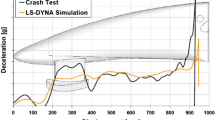Abstract
The eight-channel test rig is widely used in durability assessment of vehicle components while for some cases of rear suspension, this costly instrument is unnecessary. Based on the analysis of structure and forces, a simpler one-channel testing approach is presented for the durability calculation of a dependent rear suspension. Taking a punched rear shock tower as the study object, a FEA strain-stress analysis was first performed to determine the risk area. Then, the entire vehicle test system was created, and the proving ground tests were carried out so that the real strain on the part could be measured. Based on the road test data and the P-S-N curve of the component, the cumulative fatigue damage of a 15,000-kilometer proving ground test road was calculated, and the computational result indicates that the modified structure was safe for durability analysis. Moreover, a standard 50% S-N survival fraction curve was plotted using Corten and Dolan’s method, which can be utilized in the durability analysis for other similar components. Finally, the road test for this modified suspension structure was carried out, and the test result certified that the punched shock tower can be subjected to a 15,000-kilometer proving ground test road without the appearance of fatigue failure.
Similar content being viewed by others
References
Awamura, A., Nakajima, S. and Nakatsuji T.(1998). Prediction for truck endurance from the basis of road profile measurements. SAE Paper No. 982788.
Braccesi, C., Cianetti, F. and Pioli, D. (2005). Optimization of the process of experimental sign off of a vehicle. Int. J. Heavy Vehicle Systems 12,3, 193–206.
Grunder, B., Speckert, M. and Pompetzki, M. (1998). Design of durability sequence based on rainflow matrix optimization. SAE Paper No. 980690.
Kim, B., Kim, Y., Chun, D. M., Ahn, S. H. and Jang, J. D. (2009). Durability improvement of automotive V-belt pulley. Int. J. Automotive Technology 10,1, 73–77.
Kim, H. S., Yim, H. J. and Kim, C. B. (2002). Computational durability prediction of body structures in prototype vehicles. Int. J. Automotive Technology 3,4, 129–135.
Klyatis, L. M. (2000). The strategy of accelerated reliability testing development for car components. SAE Paper No. 2000-01-1195.
Author information
Authors and Affiliations
Corresponding author
Rights and permissions
About this article
Cite this article
Liu, J., Wang, Y. & Li, W. Simplified fatigue durability assessment for rear suspension structure. Int.J Automot. Technol. 11, 659–664 (2010). https://doi.org/10.1007/s12239-010-0078-1
Received:
Revised:
Published:
Issue Date:
DOI: https://doi.org/10.1007/s12239-010-0078-1



